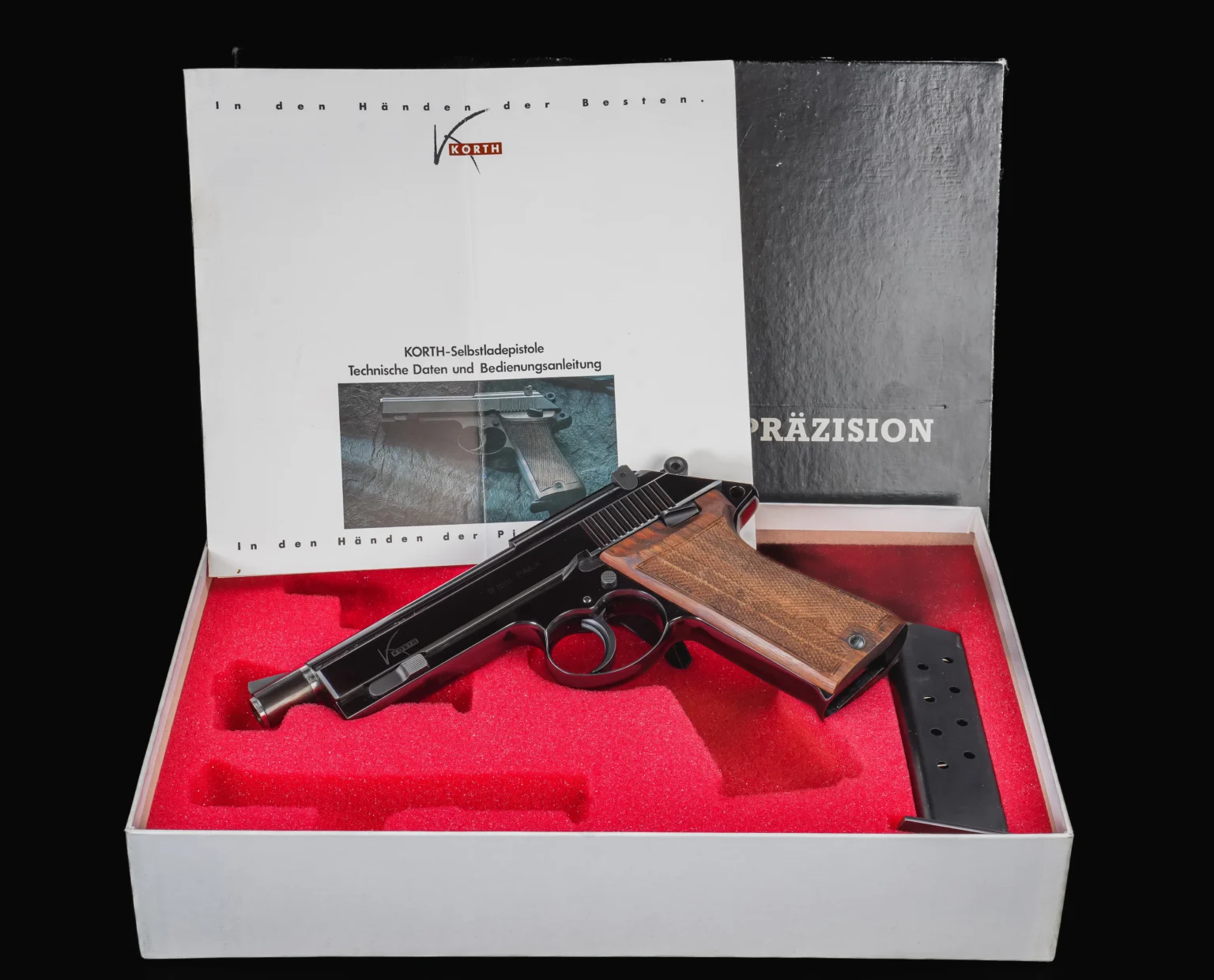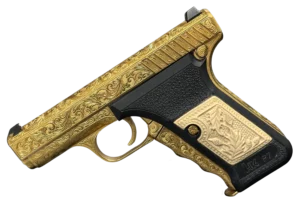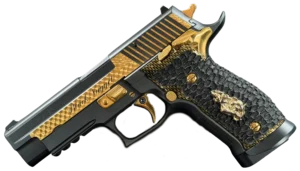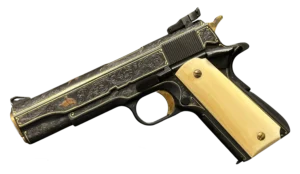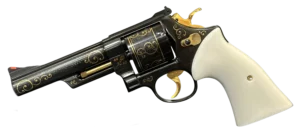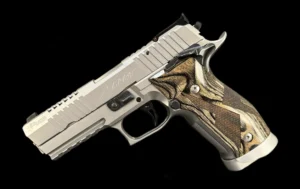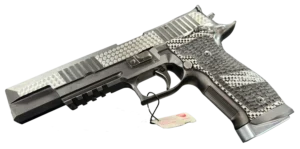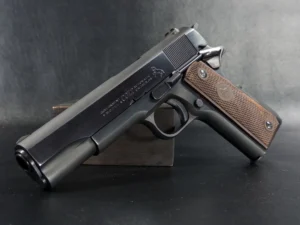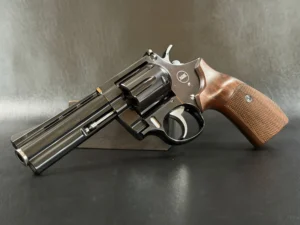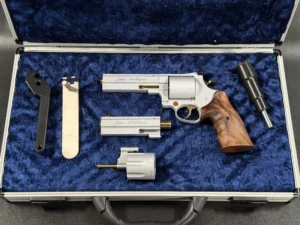Key Takeaways:
- Engineering Brilliance Rooted in Obsession with Perfection: Willi Korth’s semi-automatic pistol was a handcrafted, ground-up design that prioritized precision and safety over production efficiency. Every part was uniquely engineered—no shortcuts, no borrowed systems—reflecting Korth’s commitment to mechanical purity and innovation.
- Unique Slide and Trigger Mechanisms Set It Apart: The Korth Semi features a highly complex slide recoil system with delayed unlocking and a locking piece that reduces recoil and enhances safety. Its sophisticated trigger mechanism prevents firing out of battery and ensures a crisp, deliberate pull, far exceeding the standards of its time.
- Ultra-Rare, Historically Significant Collector’s Piece: With only a few working prototypes, the Korth Semi is one of the rarest and most collectible firearms globally. It stands as a mechanical legacy rather than a commercial product—a testament to German engineering, artisanal craftsmanship, and the pursuit of perfection.
When most enthusiasts think of Korth, they immediately recall the brand’s renowned revolvers, revered for their precision, craftsmanship, and exclusivity. Yet hidden in the shadows of these iconic wheel guns lies one of the most ambitious and intricate projects ever undertaken by German gunsmith Willi Korth: the Korth semi-automatic pistol. Developed with the same obsessive attention to detail as his revolvers, the Korth Semi remains one of the rarest and most technically fascinating firearms of the 20th century.
This article explores the design, function, and evolution of the Korth Semi, focusing particularly on its unique slide mechanics, innovative trigger system, development process, and the challenges of safety integration. Through detailed analysis and historical context, we aim to uncover why the Korth Semi is an engineering marvel and a collector’s dream.
The Slide Mechanism: Controlled Recoil and Locking Precision
At the core of Korth Semi’s mechanical brilliance is its slide assembly, which is designed with unconventional complexity and departs from traditional short-recoil systems found in most semi-automatic pistols.
Locked and Loaded
In its default state, the Korth pistol is closed and uncocked. No magazine is inserted, and the sear engages the striker in the safety notch. Upon inserting a loaded magazine and charging the slide, the striker is cocked, the mainspring is tensioned, and a round is chambered.
Upon firing, the slide assembly exhibits a distinct multi-phase motion. Initially, the entire slide travels approximately ten millimeters rearward. This brief motion is sufficient to unlock the barrel and slide assembly. The locking piece, a uniquely engineered component, disengages by sliding down a ramp on the grip frame, enabling the unlocking sequence to initiate with mechanical precision.
Controlled Opening
Once the locking piece disengages, the slide continues its rearward movement. The barrel housing remains stationary—retained by the barrel stop—while the slide and locking piece move in unison. During this action, the extractor pulls the spent cartridge casing rearward. The casing is partially extracted at about five millimeters into this rearward movement. When the full stroke is completed, it is ejected by the fixed ejector.
This well-orchestrated dance of components ensures that the spent casing clears the chamber safely while the striker is re-cocked and the sear is re-engaged. Upon returning the slide, a new round is chambered, the system re-locks, and the pistol is ready to fire again.
The Korth system distinguishes itself by the careful synchronization of the locking piece and slide. The entire assembly works harmoniously to reduce felt recoil, delay unlocking for improved safety and accuracy, and ensure robust cartridge extraction. It is an elegant solution with a clear nod to engineering purity.
The Trigger System: A Mechanical Symphony
Where most semi-automatic pistols employ a straightforward sear and trigger bar arrangement, Korth pursued a mechanically sophisticated system philosophically aligned with his vision of excellence.
The Original Configuration
In the earliest iterations, the trigger mechanism included several interacting surfaces—designated A through H—that managed everything from striker engagement to sear release and disconnector behavior. Unfortunately, while visionary, Korth’s initial blueprints were insufficiently precise to be replicated without complications.
The most glaring issue was a faulty trigger bar design. This first-generation component caused the slide to lock up during charging. When pulled rearward, it failed to interact appropriately with the disconnector cam inside the slide, creating a mechanical jam.
Korth promptly scrapped this design and reimagined the trigger bar with a distinctive right-angled rear profile. This alteration allowed the bar to interface correctly with an internal ledge inside the grip frame, providing proper downward pressure during slide operation and ensuring smooth, repeatable cycling.
Refined Operation
In the pistol’s final form, the trigger system achieves a balance of control, responsiveness, and safety:
- When at rest, the sear spring forces the trigger and trigger bar forward. This ensures that the striker is disengaged, with the sear engaging the striker’s safety notch.
- Upon charging, the slide tensions the mainspring and retracts the striker. The disconnector ensures the striker is held back until the trigger is reset.
- Only after the trigger is slightly released does the bar drop back into position, allowing the sear to catch the striker.
This system ensures that the weapon cannot fire “out of battery,” enhancing safety and consistency. It also provides a crisp and deliberate trigger pull, unmatched by most service pistols of the time.
Development History: From Workbench to Prototype
The Korth Semi’s story is also a narrative of artisanal dedication. In its initial phase, Willi Korth worked alone, designing, machining, and assembling the pistol by hand. There were no CNC machines, no outsourced labor—just pure, meticulous craftsmanship.
Handcrafted Beginnings
Korth built multiple experimental models, each iteratively refined based on performance and mechanical feedback. One variation included an extended beavertail and target-style sights—an internal version dubbed the “Sport” or “Sport-Visierung.” This version would evolve into the “Target” prototype.
Korth’s working drawings—many heavily worn from frequent handling—illustrate a constant drive for precision. One template, made of a 2.5 mm sheet of steel, was repeatedly used to align internal component axes. It served as a blueprint for everything from sea placement to magazine catch alignment.
Transfer of Responsibility
Eventually, Korth delegated further development to his business partner and a team of engineers. This phase produced near-production-ready prototypes featuring design elements like the barrel catch hook, disassembly lever, and shoulder stock interface.
Drawings from this stage reveal refinements including:
- Machining adjustments for the ejection port.
- Preparations for adjustable rear sights.
- Relocation and redesign of the mainspring guide rod and trigger return spring.
Every detail in these hand-drawn blueprints—down to the shape of the barrel housing and position of the locking block—was a product of iterative refinement and engineering excellence.
Engineering Refinement: Evolving Mechanics and Materials
As the Korth Semi approached its finalized prototype form, significant attention was paid to improving durability, reliability, and mechanical elegance. Each component underwent careful scrutiny, often resulting in custom modifications that further distanced the Korth Semi from mainstream firearms.
The Recoil Buffer Innovation
One of the key refinements in the pistol’s late-stage development was introducing a recoil buffer system. The initial concept envisioned a plastic buffer pad placed into a blind hole at the end of the slide’s return path. This would have absorbed the forward momentum of the locking piece, softening the slide’s impact.
However, this solution proved suboptimal. Instead, a steel recoil buffer with an integrated spring was developed and installed directly into the locking piece. This improved recoil management and enhanced the longevity of internal components by diffusing stress forces more effectively. It was a forward-thinking approach, akin to recoil buffering technologies in modern high-end pistols.
The Guide Rod and Decocking Safety Issue
Another subtle yet critical challenge was ensuring the striker remained safely in the decocked position. Initially, the mainspring guide rod continued to transmit force to the striker even when the action was uncocked. This prevented the sear from properly engaging the striker’s safety notch, compromising the weapon’s passive safety.
Korth’s solution was elegantly simple: He reshaped the head of the guide rod so that, in the uncocked state, it no longer transferred spring force to the striker. Instead, a smaller striker return spring held the striker in place. This clever change ensured that, upon decocking, the sear would always fall into the safety notch, making the weapon passively safe like a revolver.
It’s a rare example of a firearm design where decocking results in automatic re-engagement of the safety, not via an external lever, but through the inherent geometry of internal components. Korth saw no need for a second manual safety; the gun was always safe when uncocked.
The Second Safety: An Unwanted but Required Feature
Although Willi Korth believed in mechanical simplicity and preferred his pistol to remain free of unnecessary safety features, circumstances required him to reconsider. To participate in German military and police tenders, a secondary safety mechanism had to be implemented. Thus, the development of an automatic striker safety began.
Design and Challenges
Korth designed a safety lever integrated directly into the striker body. According to documents dated August 1981, this internal mechanism would automatically engage the Safe position during manual cocking. The pistol’s condition would then be visually indicated, giving users confidence in the weapon’s status at a glance.
Though ingenious on paper, this safety’s real-world performance left much to be desired. When tested with high-powered ammunition, the striker’s inertia caused the safety lever to unintentionally rotate backward during recoil, engaging the Safe position without user input. This malfunction rendered the safety unpredictable and ultimately unfit for service.
Despite designing and machining parts for five prototype units, Korth never fully implemented this safety. The notches required for its engagement were never cut into the strikers, and the system remained a conceptual experiment. Like many of Korth’s ideas, it was born of brilliance but abandoned in pursuit of perfection.
Prototype Problems and Final Adjustments
The Korth Semi’s mechanical path was not without setbacks. One of the most pressing issues during early testing revolved around the disconnector and the trigger bar.
The First Trigger Bar Flaw
In the original design, the trigger bar would ride forward when the pistol was uncocked. This caused a mechanical conflict with the slide, which would lock up upon charging. The fault stemmed from the inability of the trigger return spring to hold the bar in its intended position during recoil.
Korth quickly recognized this fatal flaw. He redesigned the trigger bar to include a right-angled profile at the rear. A matching ledge was milled into the grip frame, allowing the rear of the bar to “catch” properly when the disconnector cam pushed it downward. This ensured smooth slide operation and complete disconnection during cycling.
Notably, the defective original trigger bar was one of the few flawed parts Korth did not destroy, likely kept as a reminder of the need for rigorous mechanical testing.
The Final Trigger System
In the completed system:
- The compression spring acted upon the trigger bar with precise force.
- The disconnector interface was optimized for consistency.
- The bar was shaped to prevent any vertical movement that could cause interference with the slide.
Once implemented, this final version allowed the pistol to transition seamlessly between cocked and uncocked states. It also supported reliable firing, safe decocking, and complete disconnection between shots—something few pistols could claim at the time.
Philosophical Design Principles
Willi Korth was not merely building a pistol but creating a mechanical philosophy in metal. His designs always emphasized safety through simplicity, durability through thoughtful engineering, and elegance through efficiency.
No Redundant Safety
Korth’s ideal firearm would rely on fundamental mechanical relationships to ensure safety, rather than external switches or user-dependent steps. When uncocked, the Korth Semi was inert. The striker sat disengaged, the trigger could not release it, and the weapon was effectively safe.
This design choice aligned with Korth’s philosophy that the best safety requires no action from the user. In contrast to modern pistols loaded with passive and manual safety features, Korth’s vision was refreshingly minimalistic and remarkably effective.
A Collector’s Engineering Marvel
Very few Korth semi-pistols were completed, and even fewer survive today. They represent a rare confluence of mechanical ingenuity, handcrafted precision, and uncompromising vision.
Every element of the pistol was designed from first principles. Nothing was borrowed or recycled from other systems. In this way, the Korth Semi stands apart—not just as a firearm, but as a mechanical legacy.
Legacy and Collectibility
The Korth Semi was never mass-produced, saw military or police adoption, didn’t win contracts, entered widespread civilian service, or dominated competition shooting. Yet its significance within the firearms world is profound.
A Rare Artifact
Only a few working prototypes exist today, most in private collections or company archives. Each remaining example—such as Pistol 005—is a testament to the intense labor, craftsmanship, and innovation that Willi Korth poured into the project. These pistols are not just rare but mechanically unique and historically irreplaceable.
Each unit contains hand-fitted parts, experimental features, and personal notes from Korth’s development process. These aren’t just production models but artifacts of one man’s mechanical exploration. As such, they represent one of the most exclusive and fascinating corners of firearm collecting.
Market Appeal
In today’s collector market, a Korth Semi is the equivalent of a concept car from a legendary designer. While few may understand its inner workings at a glance, those who do recognize its value immediately. It combines historical rarity, mechanical brilliance, and a story of perseverance and artistry.
Interest in the Korth Semi continues to rise, especially among collectors focused on German engineering or rare prototypes. As Willi Korth’s revolvers become more sought after, the Semi stands as the next frontier for high-end collectors seeking something even rarer.
A Testament to Korth’s Philosophy
What sets the Korth Semi apart is its mechanical sophistication and the philosophy behind its creation.
Korth believed a pistol should be safe when decocked, elegant in motion, and precise in execution. He refused to take shortcuts or adopt solutions that did not meet his standards. As a result, the Korth Semi embodies a type of mechanical purity rarely seen in industrial design.
Whereas many pistols evolve from established models—borrowing locking systems, trigger groups, or frames—Korth built his from the ground up. Even the simplest elements, like the trigger return spring or guide rod, were carefully considered, iteratively tested, and, if necessary, abandoned and reimagined.
Korth’s goal wasn’t volume or profit—it was perfection. That’s why each pistol was essentially a work of art. It’s also why the Korth Semi remains so enigmatic: it wasn’t designed for the mass market. It was designed for excellence.
Conclusion
The Korth Semi-Automatic Pistol is one of the most advanced and fascinating handguns ever created—but it is also one of the least known. It is a technical tour de force, combining innovations in recoil management, trigger mechanics, and passive safety systems in a design decades ahead.
The Korth Semi tells a story of relentless innovation, from handcrafted prototypes to highly complex internal systems. It was a firearm born from one man’s obsession with excellence—a mechanical puzzle built to the highest precision standards.
Though it never reached commercial production, its influence and legacy endure. For collectors, engineers, and historians alike, the Korth Semi offers more than just rarity. It provides a window into what happens when a master craftsman is given free rein to create the perfect pistol—one component, one challenge, one solution at a time.
In a world increasingly dominated by mass production, the Korth Semi remains a reminder of what true mechanical artistry looks like—and why it still matters.
Frequently Asked Questions
Unlike most semi-automatic pistols, which use common design principles, Willi Korth built the Korth Semi entirely from scratch. It features a highly complex recoil and locking system, a sophisticated trigger mechanism, and internal safety features that reflect Korth’s philosophy of mechanical elegance and safety without relying on external safety features.
No. The Korth Semi was never commercially mass-produced or officially adopted by any military or police force. Only a few prototypes were made, primarily for internal testing and refinement. These few examples now reside in private collections and are considered highly collectible.
Its extreme rarity, unmatched craftsmanship, and historical importance make it a prized item among collectors. Each unit was handcrafted with custom-fitted parts, experimental features, and unique internal mechanics, making the Korth Semi not just a firearm but a one-of-a-kind work of mechanical art.


